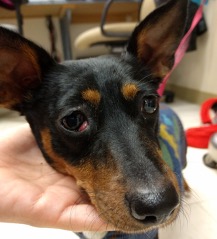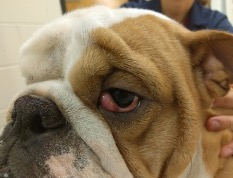“Cherry eye” is a common term for a prolapsed gland of the third eyelid. Animals, unlike humans, have a third eyelid that comes from the corner near the nose, and helps protect the eye and distribute tears over the cornea. Within the third eyelid are pieces of cartilage and a gland. The gland of the third eyelid contributes about 30-40% of the watery component to the tear film.
 Prolapse of this gland often occurs in young dogs, bilaterally or unilaterally, and may or may not be associated with a significant bend in the cartilage piece. As this condition is more common in certain breeds, there is likely a genetic component. Breed predilections include English Bulldogs, Cane Corso, Great Dane, Cocker Spaniels, Beagles, Maltese, Havanese, and others. It is suspected that the ligamentous attachments between the gland and the rest of the orbital structures are weak, which result in the gland popping out of place. If not replaced, the gland may become irritated or even desiccated, and can result in keratoconjunctivitis sicca, or dry eye.
Prolapse of this gland often occurs in young dogs, bilaterally or unilaterally, and may or may not be associated with a significant bend in the cartilage piece. As this condition is more common in certain breeds, there is likely a genetic component. Breed predilections include English Bulldogs, Cane Corso, Great Dane, Cocker Spaniels, Beagles, Maltese, Havanese, and others. It is suspected that the ligamentous attachments between the gland and the rest of the orbital structures are weak, which result in the gland popping out of place. If not replaced, the gland may become irritated or even desiccated, and can result in keratoconjunctivitis sicca, or dry eye.
 Surgical repair of the gland is always recommended, as completely removing the gland leaves patients at high risk of developing dry eye. Surgery to correct prolapse of the gland of the third eyelid carries an 85-90% success rate. The most common procedure is creating a “pocket” within the normal tissues for the gland to be placed back into. A second procedure involved “tacking” the gland down to the nearby bone or other muscles. These procedures may be combined in some patients, and may also be performed prophylactically in patients at risk of prolapse in the second eye.
Surgical repair of the gland is always recommended, as completely removing the gland leaves patients at high risk of developing dry eye. Surgery to correct prolapse of the gland of the third eyelid carries an 85-90% success rate. The most common procedure is creating a “pocket” within the normal tissues for the gland to be placed back into. A second procedure involved “tacking” the gland down to the nearby bone or other muscles. These procedures may be combined in some patients, and may also be performed prophylactically in patients at risk of prolapse in the second eye.
Complications following surgery may include:
- Sutures untying and/or rubbing on the eye, creating a corneal ulcer
- Failure of the surgical procedure, requiring a repeat or different procedure (this may or may not include addressing any bend in the T-shaped cartilage associated with the gland)
- Cosmetic asymmetry, which is generally not noticeable, but sometimes tacking the gland back in place creates a slight difference in the lower eyelid conformation